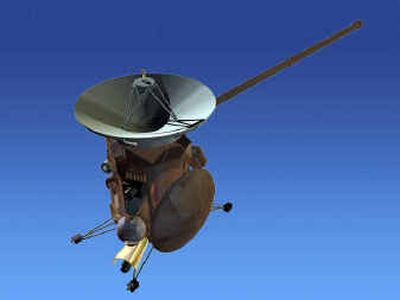Rendezvous with Saturn

WASHINGTON – After an almost seven-year, 2.2-billion-mile journey, the Cassini spacecraft is zooming toward a historic rendezvous with Saturn tonight. If a critical maneuver to slow it down succeeds, Cassini will spend at least the next four years touring Saturn, its rings and its icy satellites, snapping pictures and taking scientific measurements. On Christmas Eve, the tiny Huygens probe will detach from Cassini and plunge to the surface of the moon Titan, a satellite that scientists hope will offer insights into the early days of our own planet. For the scientists and engineers from NASA, the European Space Agency and the Italian Space Agency, some of whom have devoted more than 15 years to the $3-billion project, tonight is the moment they’ve been waiting for. Shortly after 7:30 p.m. PDT, Cassini’s rocket engine will begin a 96-minute deceleration burn, slowing down the craft so that it can enter Saturn’s orbit. The trip is “a spectacular ride,” said Robert Mitchell, the Cassini program manager at NASA’s Jet Propulsion Laboratory. The probe will start below the ring plane, shoot through the gap between two of Saturn’s distinctive rings, then point back down and begin sending images of the rings and other data. The trip through the ring plane is the closest Cassini will get to Saturn. Engineers at Jet Propulsion Laboratory have checked and rechecked all of the systems on board the spacecraft, Mitchell said, and the confidence level is high. But stomachs will be churning, as always, as the probe approaches the beginning of the burn. “In all likelihood, it will be just that simple. But it’s not a slam dunk,” Mitchell said at a recent briefing. “I’ll sleep better once this thing is all done and in orbit.” The biggest danger to the spacecraft is the dust and other particles that lurk in the ring area. But Mitchell said the probe would be turned so that its high-gain antenna will shield almost the entire craft. Mission controllers at the propulsion laboratory will be following Cassini on a radar image and waiting for it to send back a “call home” signal indicating everything is working, Julie Webster, the spacecraft team chief, said Tuesday. Saturn is the sixth planet from the sun and the second largest in the solar system, after Jupiter. Named for the Roman god of agriculture, it is the least dense planet – composed mainly of hydrogen and helium – and the only one that is lighter than water. What fascinates scientists is the potential for Saturn and its 31 known moons to offer clues into how the solar system formed. “In a sense, Saturn’s system is a miniaturized solar system,” said Charles Elachi, the Jet Propulsion Laboratory’s director and the science team leader for Cassini. Three spacecraft previously have flown by the planet: Pioneer 11 in 1979, Voyager 1 in 1980 and Voyager 2 in 1981. But none of these studied Saturn in the kind of detail that Cassini will. Cassini already has been through a phenomenal 2.2 billion-mile journey just to get this close to Saturn. Launched from Cape Canaveral Air Station in October 1997, Cassini needed four gravity assists from other planets – two from Venus, one from Earth and another from Jupiter – to conquer the distance. Of all the satellites gathered around Saturn, Titan is thought to hold the most promising information. Bigger than Mercury and Pluto but smaller than Mars, Titan is almost like a planet, Elachi said. It also is the only moon in the solar system that has a dense atmosphere – one-and-a-half times more dense than Earth’s — composed mostly of methane and nitrogen. On Titan, Elachi said, the methane behaves much the same way as the water vapor on Earth, forming clouds that rain into lakes and rivers. Some scientists think locked inside Titan’s cold surface are “pre-biopic” elements that resemble Earth before life emerged here. Cassini will fly by Titan 45 times, coming as close as 590 miles above the surface. And the probe Huygens will get even closer, entering Titan’s atmosphere on Jan. 14 after a 20-day free fall from Cassini. Swinging from its parachutes, Huygens will spend two and a half-hours taking scientific measurements, pictures and sounds. It will then beam them back to Cassini, which will relay them to Earth. Huygens is expected to survive on the surface of Titan only briefly.